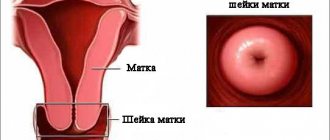There is a period in the life of every woman when she is capable of conceiving, bearing and giving birth to viable offspring. In science, it is called reproductive age. In Russia, this period falls on 15-49 years; in other countries, the border can fluctuate significantly. According to the World Health Organization, the ability to bear children (fertility) is realized between 15 and 44 years of age. However, for each individual woman, setting the boundaries of childbearing age is influenced by many factors: genetic background, lifestyle, the presence or absence of bad habits and health status at the time of conception.
What is reproductive age
From a medical point of view, a woman’s fertile age is the period of time during which she is capable of bearing children. In this case, not only the possibility of fertilization of the egg is taken into account, but also the ability of the body itself to bear a healthy child. Often during early or late pregnancy there is a threat of premature birth, psychological problems, fetal development abnormalities, etc.
Therefore, doctors recommend taking a better and more responsible approach to the issue of pregnancy planning and choosing the appropriate period.
With age, the number of eggs decreases, ovulation occurs much less frequently, and the amount of estrogen in the blood decreases. As a result, the chances of fertilization and the birth of healthy offspring are reduced. Even if pregnancy occurs, the likelihood of giving birth to a full-fledged child is significantly reduced. With age, the risk of genetic abnormalities increases, including Down syndrome, neural tube defect and others. Babies are also born with more severe pathologies.
Reproductive age is conventionally divided into:
- Early period. So named due to the young age of the girls. The cycle begins from the moment of the first menstruation and ends around 20 years. This is the period when the egg is ready for fertilization. Transformations occur in the body aimed at ensuring normal pregnancy. In this case, ovulation may be unstable, but there is a chance of having children.
- Middle period. The phase begins around age 20 and ends around age 35. During this period, the menstrual cycle is stable. The body fully produces the hormones necessary for conceiving and bearing a full-fledged child. This is the ideal time and the most suitable period.
- Late reproductive age. According to various sources, it begins at the age of 35 or 40 and continues until the age of 45. In adulthood, women experience hormonal changes. Thus, the body prepares for the onset of menopause. At the same time, the menstrual cycle can remain stable. Ovulation occurs regularly. However, much less frequently than during the early or middle reproductive period. To bear and give birth to a healthy child, constant monitoring by medical personnel and screening tests are required. Additionally, in some cases, maintenance hormonal therapy is indicated.
- Decaying period. The phase begins at about 45 years and ends at about 60. It is so named because at this age ovulation is more a rarity than a rule. They don't happen often. The menstrual cycle becomes unstable, periods are scanty, and hormonal levels change. During this period, there is a low probability of conception, but children are still born. Bearing is carried out using supportive medications.
In rare cases, the age limits of different periods may be shifted in one direction or another. It all depends on the individual characteristics of the body.
Female Fertility Rates
There are three important indicators of female fertility: ovulation, tubal patency and endometrial condition. If there are problems with conception, the doctor prescribes several methods that can answer the question: can a woman become a mother.
An ovulation test is carried out using either special strips that determine the concentration of the hormone in the urine on the eve of ovulation, or using an ultrasound examination that can assess the size of the dominant follicle and the thickness of the inner layer of the uterus.
Two methods help the doctor assess the patency of the fallopian tubes: metrosalpingography and hydrosonography. During the first one, a contrast solution is injected into the uterine cavity, which will be reflected on an x-ray and show the patency or obstruction of the tubes. In the second case, an ultrasound is used instead of an X-ray, and the contrast solution is replaced with saline solution heated to body temperature.
To assess the endometrium, ultrasound examination is prescribed on different days of the menstrual cycle. This allows you to assess the thickness of the inner layer of the uterus and its readiness to receive a fertilized egg.
Every month in the body of every woman, under the influence of follicle-stimulating hormone produced in the pituitary gland, a follicle grows in one of the ovaries (less often in both). When it reaches the required degree of maturity, an egg is released. This process is called ovulation. The egg is released into the fallopian tube, where it can be fertilized by a sperm. If fertilization does not occur within 24 hours, the female cell dies, the endometrium begins to be rejected and is released in the form of menstrual flow.
Best age to have children
The best childbearing age for a woman, according to experts, is from 20 to 37 years. After 40 years, it is more difficult for the body to cope with the stresses resulting from pregnancy and gestation. The risk of miscarriages, premature births, placental abruption, etc. increases.
According to statistics, the average age of women giving birth is 22-35 years. However, just a few decades ago, even 30-year-old ladies were considered old-timers. Doctors were wary of such pregnant women. In most cases, excessive age was an indication for cesarean section.
Now there is a tendency to increase the number of mature pregnant women. Today, as a rule, even a 40-year-old woman in a maternity hospital surprises few people. However, this age is not considered optimal.
This is due to various factors. Most modern ladies take care of their health. As a result, the abdominal muscles remain elastic, there are no problems with the pelvic bones and other organs, and there are no serious pathologies.
Fertility index for men?
In men, the fertile age can be longer, from 14 to 60 years; there is evidence that even at the age of 80 a man can conceive a child, which has a lot of evidence in history. But taking into account the environment, harmful industries, and habits, usually by the age of 50, many men have reduced motility and the number of sperm produced.
In order to determine a woman's fertilization ability, you need to find out the man's fertility index. With the help of laboratory tests of sperm, the so-called spermogram, you can find out the possibility of fertilization of an egg in just one sexual act. After a spermogram using the Kruger and Farris index, doctors can accurately predict the sperm's ability to fulfill its goal and fertilize an egg.
The Farris index indicates the number, as well as the apparent percentage, of sedentary, live, mobile and immobile tadpoles in one milliliter of sperm or in its total quantity. If a man’s sperm indicators reach an index value of 20–25, then the man has normal fertility. When the value exceeds 25, increased fertility is noted; if it drops to 20 and below, decreased fertility is recorded.
Using the Kruger index, parameters such as the size of the sperm head, tail and neck are determined; the final result is expressed as a percentage of the number of completely healthy sperm and those with sperm defects. If the index number is more than 30%, this means high fertility; if lower, this means low, bad fertility.
Consequences of late childbirth for women and children
A woman’s reproductive age makes it possible to enjoy pregnancy both at a very young age and at a fairly mature age. Often, it is after 40 years that many people manage to get pregnant for the first time, despite the fact that they have been diagnosed with infertility for many years. There is no scientific explanation for this fact.
Doctors do not have a very favorable attitude toward first-time mothers and pregnant women carrying a fetus to term at this age. However, many young ladies do not dare to terminate their pregnancy, despite the high probability of a not very favorable development of events.
Thus, the consequences of late pregnancy and childbirth include:
- miscarriage and premature birth;
- genetic abnormalities in the fetus;
- diabetes mellitus in a woman in labor;
- placental abruption;
- impaired blood circulation and nutrition of the fetus;
- fetal developmental delay;
- fetal death;
- exacerbation of chronic diseases in a primigravida woman;
- complicated childbirth, decreased labor activity.
Due to the high risk of complications, the expectant mother is recommended to undergo a full comprehensive examination and be observed by a gynecologist.
It is worth noting that late pregnancy also has its obvious advantages. Menopause occurs much later, life expectancy increases, the condition of nails, hair, and skin improves, the risk of developing cancer decreases, etc. Older mothers look significantly younger than their peers. Many give birth to a second baby during this period.
Infancy and childhood (0-9 years)
Prematurity, fetal asphyxia at birth and infections are the leading causes of death during the first month of life. The causes of death in infancy and childhood are the same for both sexes. However, in some cultures, gender-based discrimination leaves girls vulnerable to the threat of sex-selective abortion and female infanticide. An estimated 18% of girls experience sexual violence at some point in their childhood, compared with 8% of boys [9]. In some countries, girls have limited access to vaccines, health services and adequate nutrition compared to boys [10]. Preference for male children may result in shorter periods of exclusive breastfeeding for girls.
Can a woman get pregnant after 30, 40, 50 and 60 years of age?
Despite the fact that the ideal age for childbirth is up to 30 years old, as mentioned earlier, a woman can become pregnant and carry a baby much later.
Between 30 and 40 years, the chances of conceiving are slightly lower than in the early or middle period.
After forty, the probability decreases every year. When pregnancy occurs, you should discuss the danger with your doctor and listen to his opinion, as well as common sense, up to what age you can give birth, and after what age the risk is unjustified.
Even after 60 years of age, it is possible to have healthy children. However, it is important to understand that in addition to life itself, the child also needs to be given love, care, education, etc. With late motherhood, the chances of this are significantly reduced. It is necessary to be aware of the age at which a child needs healthy, full-fledged parents.
Why are there more and more older first-time mothers today?
“It is always important for a doctor to determine the reasons why a woman delayed motherhood, medical or social. It is more difficult to work with medical ones; they require large-scale examinations, scrupulous analytics, and often consultations of specialists in order to eliminate all risk factors. We include congenital or acquired chronic somatic diseases, diagnosed miscarriage, various gynecological pathologies, previous inflammatory processes, complicated early abortions. Social ones are less alarming: this is the desire of women to first provide a financial base, to realize themselves in a profession, to arrange a life, that is, to find a worthy father for their future children; sometimes motherhood is postponed by well-established and generally healthy women who are simply not confident in their partner and the stability of the relationship with him,” notes the gynecologist.
In any case, as the specialist says, late pregnancy is a special challenge for the doctor, too, because increased attention, more in-depth diagnosis and vigilant monitoring are required. The test sheet for such an expectant mother may be 10-12 points longer than that of a young woman in labor.
Child towards retirement. Features of “adult” childbirth Read more
How to increase reproductive function
When discussing the problem of what age is best to give birth, it is worth paying special attention to the issue of increasing reproductive function.
To do this, special attention should be paid to the following factors:
- Bad habits. To prolong the period of successful conception and birth of a healthy child, you should stop drinking alcohol and smoking traditional cigarettes. Nicotine constricts blood vessels, which means that blood circulation and oxygen supply to the ovaries, uterus, and all other organs and systems are disrupted. The effects of alcohol on the body are similar. In this case, it doesn’t matter how much a person drinks and smokes. The result is the same – decreased fertility.
- Passive lifestyle. This is the second most common factor. Lack of physical activity leads to poor circulation in the pelvis. As a result, the chances of conception and pregnancy are significantly reduced.
- Poor nutrition. The reproductive organs need vitamins, minerals and other substances. Proper, balanced nutrition helps improve and increase the likelihood of pregnancy and conception.
- Stress and lack of sleep. Excitation of the nervous system has a negative effect on the body as a whole. It is necessary to avoid stressful situations and take care of proper sleep.
- Diseases. It is important to take care of your health. Particular attention should be paid to the reproductive organs.
- Excess weight. If it is present, it is quite difficult for even young girls to get pregnant and carry a child to term, no matter how old they are. To improve your chances, you should first lose weight.
To prolong fertility, you should approach the issue comprehensively.
Factors affecting fertility
Reproductive doctors ask the question: why are some women able to easily conceive and give birth to a child, even after several abortions and with chronic diseases, while others, despite being in normal health, experience problems conceiving and bearing? The reason for the decline in fertility lies in many factors:
- Having bad habits;
- Passive lifestyle;
- Unbalanced diet;
- Frequent stress;
- Hormonal imbalances;
- Diseases of the reproductive organs;
- Chronic diseases;
- Age (over 35 years old);
- Previous abdominal surgeries;
- Excess weight.
Can a woman get pregnant from an older man?
Also, when planning a pregnancy, it is important to take into account the reproductive age of a man. According to statistics, already from the age of 14-15, a young man is capable of procreation. The period of 18-25 years is the most favorable for conception.
With age, the level of the male hormone, testosterone, in the blood decreases, and at the same time, libido fades. However, this does not mean that an elderly man completely loses the ability to conceive. It also makes people pregnant.
Even at 70 years old, some representatives of the stronger sex are able to produce full-fledged offspring. There are many such examples. Some resort to the services of reproductive medicine, others conceive on their own, but the fact remains that getting pregnant and having children from an older man is quite possible and realistic. It is not dangerous, and therefore has no contraindications.
Early reproductive period
From the moment of the first ovulation and menstruation, the girl enters the early and most optimal period of her life, when the ability to conceive and give birth to children is determined by the natural abilities of the body. However, doctors agree that it is undesirable to give birth before the age of 19, since the body of a girl in adolescence is not fully formed. For example, the nervous and endocrine systems continue to improve, but the cardiovascular and excretory systems are not ready to cope with heavy loads. Pregnancy before the age of 19 can be a serious stress for the developing body. In addition, childbirth at such a young age is rarely without complications, including:
- rapidity of childbirth;
- weak labor activity;
- ruptures of the cervix and perineum;
- discrepancy between the size of the pelvis of the expectant mother and the fetal head;
- possible bleeding;
- premature birth.
Pregnancy and childbirth occurring between 20 and 35 years are considered the most favorable. The woman has developed both physically and personally, and has also achieved a certain social status. The body is formed: hormonal balance is maintained at the required level, the reproductive system most often works without failures, the articulation of the pelvic bones is mobile, the muscles of the pelvis and uterus are extensible. Until the age of 35, women usually do not have chronic diseases. Young mothers, whose age is not more than 35 years old, recover faster after childbirth, they are less likely to have problems with breastfeeding, and childbirth proceeds more favorably.
How many women of reproductive age are there in Russia?
When talking about the age at which a woman can give birth, it is worth turning to official statistics. Today in Russia the number of women of fertile age is about 40 million. 6 million, according to the official register, are considered infertile and, for one reason or another, are unable to conceive or bear children.
This is a fairly high figure, especially taking into account the fact that the best age for childbirth is taken into account. In Europe, the total number of infertile women is 5%. In Russia this figure exceeds 15%, which is several times higher.
Historical framework
At different times, the requirements for childbirth also changed, or more precisely, the age threshold for a woman when, according to doctors, it was best for her to give birth to her first child. “At the end of the 18th century, when the first official medical work on obstetrics and gynecology by Nestor Ambodik, “The Art of Midwifery, or the Science of Womanhood,” appeared in Russia, those who had not given birth before the age of 20 were considered old-timers,” says the gynecologist.
In the Soviet Union, medicine was much better, and therefore this limit was moved to 26 years. However, time does not stand still, and today, as everyone knows, various reproductive technologies are used, which often make it possible not to look back at the biological clock. “At the beginning of the 21st century, we are recording a new range: today, women’s childbearing period is from 18 to 45 years old, and they fall into the segment of “aged primiparas” after 32. We consider the optimal age to be from 19 to 28 years, and the critical age is 35-45,” - says Svetlana Botasheva.
At the same time, just like 200 years ago, the main variable in the pregnancy equation remains the supply of follicles allocated to a woman. It is laid down by nature and genetics, says the doctor. It is worth remembering that it is limited and ends. Menopause will still occur sooner or later, and this is actually the impossibility of either conceiving or giving birth. As the specialist notes, you can prolong your childbearing potential using the following measures:
- correct lifestyle;
- careful health monitoring using modern technologies and methods;
- responsible attitude towards oneself;
- innovative methods in reproduction.
Not from this childish world. Is there a limit to reproductive age? More details
Legislation and register of women of reproductive age
When discussing the topic at what age a woman is considered old-timer in Russia, attention should be paid to legislation. According to it, middle-aged women are required to undergo screening tests to identify genetic abnormalities in the fetus. The presence of chromosomal abnormalities is an indication for termination of pregnancy.
If the defect can be eliminated medically, medical personnel have no right to insist on an abortion. If the law is violated, it is better for a citizen of the state to write a complaint to law enforcement agencies.
The register of women of reproductive age includes a category of women with diseases that complicate the process of pregnancy and threaten the life of the mother and baby. In this case, conception and pregnancy are dangerous. The state provides such girls with contraceptives free of charge and enters them in a separate register.
You can learn more about fertility, optimal childbearing age, at what age menopause occurs, and more from the video:
Fertility Predictions – How is the Test Performed?
The female reproductive system is a very complex mechanism and is under constant control of hormones responsible for the coordinated functioning of the ovarian-menstrual cycle, which lasts on average 28 days. This cycle is divided into phases: menstrual, postmenstrual, and premenstrual.
- The phase of relative infertility (sterility) occurs from the end of menstruation of the current cycle until the time of ovulation in a successive cycle. Thus, the first phase of the ovarian-menstrual cycle actually deprives a woman of fertility and makes her temporarily infertile.
- The female fertility phase falls in the middle of the cycle, the moment when the probability of becoming pregnant is extremely high compared to other periods of the menstrual cycle. It coincides with ovulation and 48 hours after it. For 14 hours, the egg is able to maintain its ability to be fertilized. Spermatozoa are able to maintain their viability for 3–5 days. This is the reason for indicating the fertile phase in intervals between 6–8 days from the tenth day of the menstrual-ovarian cycle.
K = N/n*1000
N is the number (total) of newborn children, for example, in 1 year or 5, 10 years;
n - means the total number of women aged 15–50 years living in the region of the estimated fertility rate;
K is the fertility rate.
The fertile age of a man is considered to be the moment of puberty of a boy at the age of 14–16 years. From then until almost the end of his days, the male body produces sperm. It turns out that, unlike women, the male sex has no age limits for reproduction. But there are many other factors that influence reproduction as you age.
It is generally accepted that 60 years is the age after which men should not conceive a child. But there are some exceptions. Not long ago, an 85-year-old grandfather became a father and gave birth to a healthy child, but playing such games is dangerous.
To successfully create life, women and men need to be aware of their fertility status. Now, in order.
A man is able to maintain his reproductive function until the end of his days if he leads a healthy lifestyle and does not succumb to the influence of internal (ecology, physical fatigue, poor nutrition, etc.) and psychological (constant stress, emotional overload, lack of adequate sleep) life factors. Thus, a man is always ready to conceive a child; his fertile period begins from the beginning of sperm production.
Very often, young people cannot conceive a child, having constant sex life without contraceptives. In such cases, both sexual partners must undergo a full examination of their reproductive organs and sex hormones. What examinations should a man undergo?
Levels
A woman is diagnosed with low fertility if she has only two components. For example, she can get pregnant on her own, but it is not realistic for her to bear a fetus.
Normal levels of fertility in a woman who can become pregnant, carry to term without hormonal stimulation, and give birth on her own.
With a high level of fertility, a woman can give birth several times, while the interval between births is minimal. In such patients, pregnancy can occur even during menstruation or lactation.
Interesting! No contraceptive method is 100% guaranteed. The average rate of “unlucky” people ranges from 1 to 3%, and these people are mainly women with high fertility.
Why is it decreasing?
Decreased or impaired fertility in women is a condition in which the likelihood of conceiving and bearing a baby is reduced under the influence of unfavorable factors or is completely absent. Signs and symptoms of decreased fertility are obvious - conception does not occur or pregnancy cannot be carried to term. A fertile woman who has unprotected sex becomes pregnant within about a year. If this does not happen, after a year of planning, it is recommended that she and her spouse consult a doctor to determine the reasons for the decrease in fertility. Remember, we are not talking about infertility as such, we are talking specifically about identifying the causes and factors of decreased fertility of partners.
The violation may be temporary, surmountable, or irreversible. It all depends on what reason caused the changes that prevent procreation. But even with an irreversible violation, there is a way out - it will not be possible to conceive naturally, but IVF and other assisted reproductive technologies will come to the rescue.









